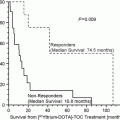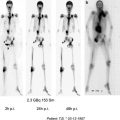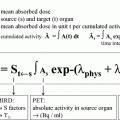© Springer-Verlag Berlin Heidelberg 2012
Richard P. Baum (ed.)Therapeutic Nuclear MedicineMedical Radiology10.1007/174_2012_733Radioembolization: Clinical Results Hepatocellular Carcinoma
(1)
Division of Interventional Radiology, Department of Radiology, Northwestern University, Chicago, IL, USA
(2)
Division of Hepatology, Department of Medicine, Northwestern University, Chicago, IL, USA
(3)
Division of Interventional Radiology, Department of Radiology, Medicine and Surgery, Northwestern University, 676 N St Clair, Suite 800, Chicago, IL 60611, USA
Abstract
Radioembolization is a transarterial therapy which delivers locoregional tumoricidal radiation doses to liver tumors. In this chapter, we present an overview of the available clinical data for this treatment option which is establishing its role in the management of liver tumors. Prospective analyses are needed to ascertain the benefit of radioembolization over other available therapies.
1 Introduction
Although secondary are more common than primary liver tumors, the incidence of primary liver tumors is increasing (El-Serag 2002). Surgery is the only definitive curative option available (Mazzaferro et al. 1996). Hepatocellular carcinoma (HCC) is the most common primary liver tumor and is responsible for over half a million deaths annually.
Due to a variety of reasons (advanced stage, comorbidities), not all patients are surgical candidates. The use of chemotherapeutic agents has limited role in the treatment of HCC (Llovet et al. 2008). Interventional oncology has established its role in the management of liver tumors. Image-guided therapies minimize the rates of systemic toxicity with an increased tumoricidal effect. These therapies have been shown to have a palliative role and may also prove to have a potentially curative role.
The unique predominant blood supply of normal hepatic parenchyma is by the portal vein, while the hepatic tumors are supplied by the hepatic artery. This allows transarterial delivery of high doses of therapeutics to liver tumors. Radioembolization is a transarterial therapy for liver tumors by which high-dose radiation could be delivered to the tumor via the artery supplying it (Salem and Thurston 2006).
TheraSphere ®
TheraSphere® (MDS Nordion, Ottawa, Canada) consists of nonbiodegradable glass microspheres (diameter range: 20–30 µm). It was approved by the Food and Drug Administration (FDA) in 1999, and has recently been approved for use in HCC patients with portal vein thrombosis (PVT). Vials of six different activities are available. The only difference in the vials is the number of spheres. 1.2 million microspheres are present in a vial with an activity of 3 Gigabecquerel (GBq). Each microsphere has an activity of 2,500 Bq at the time of calibration. The activity of the vial varies inversely with the time elapsed after calibration.
SIR–Spheres ®
SIR-Spheres® (Sirtex Medical, Lane Cove, Australia) consist of resin microspheres that are also nonbiodegradable. The spheres have slightly increased diameter and lower specific gravity per microsphere than glass. The use of SIR-Spheres® was approved by the FDA for metastatic colorectal cancer to the liver in 2002. One vial of 3 GBq is available with 40–80 million microspheres with each microsphere measuring from 20 to 60 µm, with a specific activity of 50 Bq/sphere at the time of calibration.
The purpose of this chapter is to report on the clinical data present on radioembolization for primary liver tumors.
2 Primary Liver Tumors
The role of radioembolization has been studied for the treatment of HCC in detail. Its use in the management of intrahepatic cholangiocarcinoma has also been studied but is beyond the scope of this chapter.
2.1 Role of Radioembolization in Management of HCC
2.1.1 Patient Selection
Hepatocellular carcinoma management is a multidisciplinary task. Hepatologists, oncologists, transplant surgeons and interventional radiologists are some of the members of the team involved in HCC management. The patients should be selected for radioembolization after a consensus of this multidisciplinary team. As shown below, the role of radioembolization is not limited by the stage of the disease. Patients with United Network for Organ Sharing (UNOS) T1 or T2 are considered to be eligible for transplant. Patients with HCC that has distant metastases are the only ones who have not been shown a survival benefit after treatment.
2.1.2 Indications and Efficacy
2.1.2.1 Patients within Transplant Criteria
The patients within Milan criteria i.e., single lesion less than 5 cm or less than or equal to three lesions all less than 3 cm, are eligible for transplantation (Mazzaferro et al. 1996). Resection is possible if liver cirrhosis is well-compensated. The use of surgical options is the gold standard of treatment for these patients. Limited availability of donor organs for orthotopic liver transplantation (OLT) and the dropout of patients due to tumor progression limit the number of patients who were initially within transplant criteria and are able to undergo OLT. Ablation has a controversial role given the risk of tract seeding in these transplant-bound patients.
Radioembolization has been shown to limit HCC progression. This allows the patient more time to wait for donor organs and thus increases chances of OLT. Thus, it has a role of bridging the patient to OLT. Data are required to validate this role of radioembolization.
2.1.2.2 Patients beyond Transplant Criteria
The patients who are outside transplant criteria but do not have malignant PVT or metastatic HCC are candidates for locoregional therapies such as chemoembolization and radioembolization. Downstaging allows patients who were initially outside Milan criteria to become eligible for transplant.
Kulik et al. reported data on 35 UNOS T3 patients in the Journal of Surgical Oncology (Kulik et al. 2006). They conclude that radioembolization may have a role in downstaging HCC to within transplant criteria. There is an increase in overall survival in these patients as well (Kulik et al. 2006).
Lewandowski et al. compared chemoembolization to radioembolization in their retrospective analysis on 86 UNOS T3 patients with HCC beyond the Milan criteria (Lewandowski et al. 2009). Downstaging to UNOS T2 (within Milan criteria) was achieved in 31 % patients treated with chemoembolization, and 58 % patients treated with radioembolization. Radioembolization was shown to be a better tool than chemoembolization for downstaging the disease to within transplant criteria.
The recurrence free survival and overall survival after OLT in the patients with downstaged HCC is yet to be compared to that of patients who were already within transplant criteria to determine the efficacy of downstaging.
2.1.2.3 Patients with Advanced Disease
Patients with portal vein thrombosis (PVT) have been shown to have favorable outcomes following radioembolization (Kulik et al. 2007). Systemic therapy with sorafenib has been shown to have a statistically significant improvement in survival in patients with advanced disease (Llovet et al. 2008). Embolic forms of treatment are relatively contraindicated in patients with malignant PVT as this may lead to compromise of the vascular supply of normal hepatic parenchyma.
Stay updated, free articles. Join our Telegram channel

Full access? Get Clinical Tree








